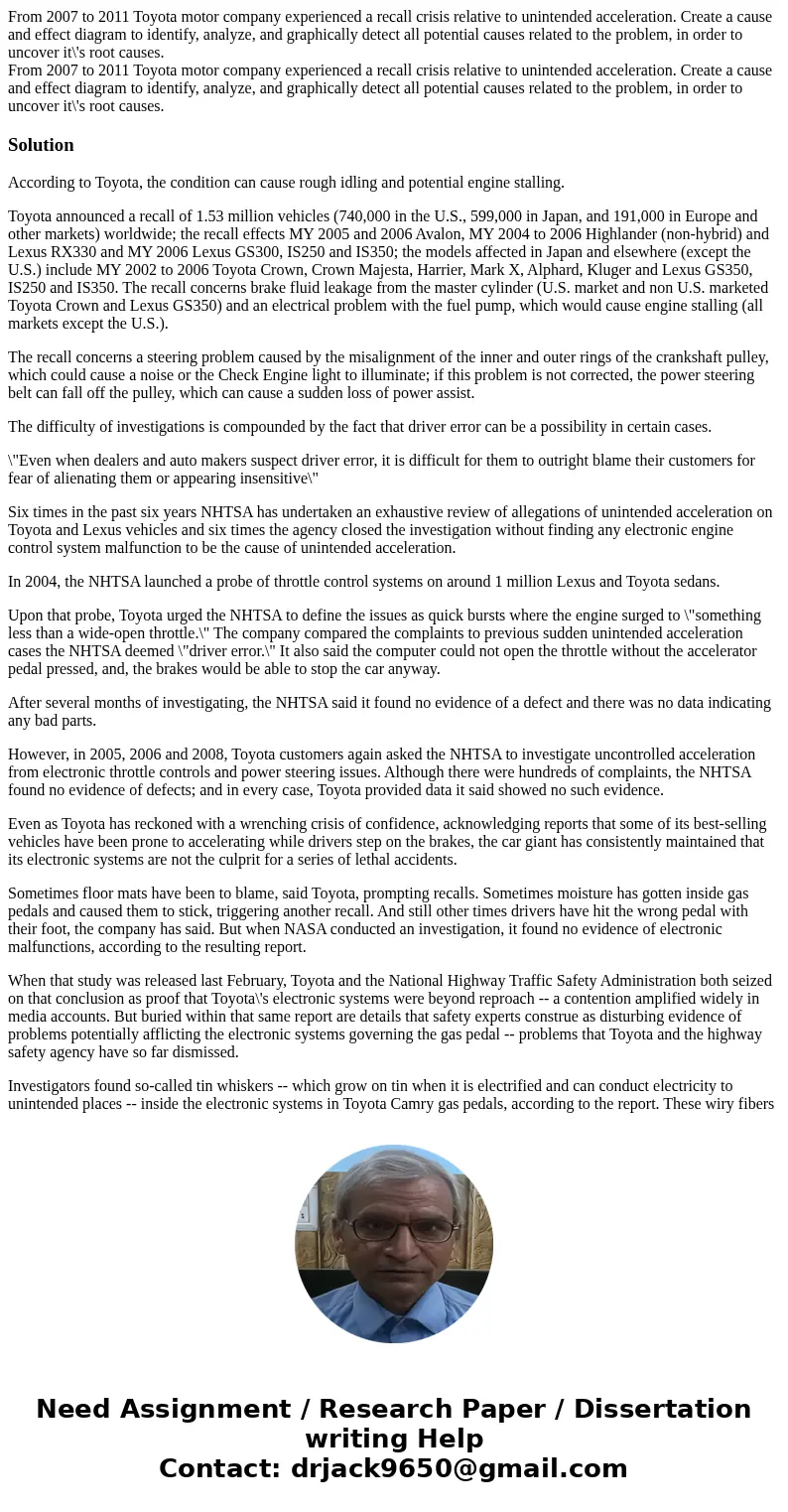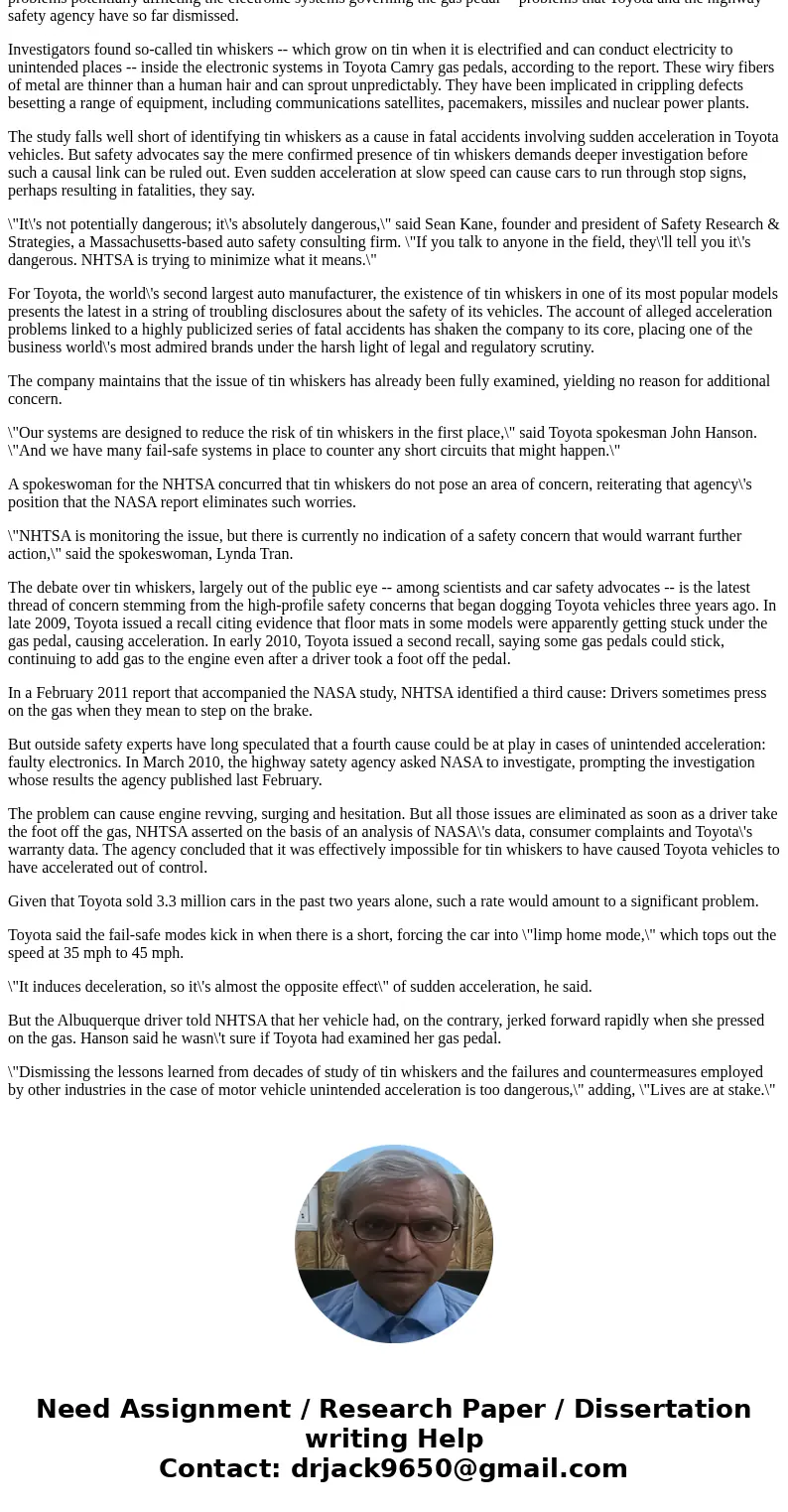From 2007 to 2011 Toyota motor company experienced a recall
Solution
According to Toyota, the condition can cause rough idling and potential engine stalling.
Toyota announced a recall of 1.53 million vehicles (740,000 in the U.S., 599,000 in Japan, and 191,000 in Europe and other markets) worldwide; the recall effects MY 2005 and 2006 Avalon, MY 2004 to 2006 Highlander (non-hybrid) and Lexus RX330 and MY 2006 Lexus GS300, IS250 and IS350; the models affected in Japan and elsewhere (except the U.S.) include MY 2002 to 2006 Toyota Crown, Crown Majesta, Harrier, Mark X, Alphard, Kluger and Lexus GS350, IS250 and IS350. The recall concerns brake fluid leakage from the master cylinder (U.S. market and non U.S. marketed Toyota Crown and Lexus GS350) and an electrical problem with the fuel pump, which would cause engine stalling (all markets except the U.S.).
The recall concerns a steering problem caused by the misalignment of the inner and outer rings of the crankshaft pulley, which could cause a noise or the Check Engine light to illuminate; if this problem is not corrected, the power steering belt can fall off the pulley, which can cause a sudden loss of power assist.
The difficulty of investigations is compounded by the fact that driver error can be a possibility in certain cases.
\"Even when dealers and auto makers suspect driver error, it is difficult for them to outright blame their customers for fear of alienating them or appearing insensitive\"
Six times in the past six years NHTSA has undertaken an exhaustive review of allegations of unintended acceleration on Toyota and Lexus vehicles and six times the agency closed the investigation without finding any electronic engine control system malfunction to be the cause of unintended acceleration.
In 2004, the NHTSA launched a probe of throttle control systems on around 1 million Lexus and Toyota sedans.
Upon that probe, Toyota urged the NHTSA to define the issues as quick bursts where the engine surged to \"something less than a wide-open throttle.\" The company compared the complaints to previous sudden unintended acceleration cases the NHTSA deemed \"driver error.\" It also said the computer could not open the throttle without the accelerator pedal pressed, and, the brakes would be able to stop the car anyway.
After several months of investigating, the NHTSA said it found no evidence of a defect and there was no data indicating any bad parts.
However, in 2005, 2006 and 2008, Toyota customers again asked the NHTSA to investigate uncontrolled acceleration from electronic throttle controls and power steering issues. Although there were hundreds of complaints, the NHTSA found no evidence of defects; and in every case, Toyota provided data it said showed no such evidence.
Even as Toyota has reckoned with a wrenching crisis of confidence, acknowledging reports that some of its best-selling vehicles have been prone to accelerating while drivers step on the brakes, the car giant has consistently maintained that its electronic systems are not the culprit for a series of lethal accidents.
Sometimes floor mats have been to blame, said Toyota, prompting recalls. Sometimes moisture has gotten inside gas pedals and caused them to stick, triggering another recall. And still other times drivers have hit the wrong pedal with their foot, the company has said. But when NASA conducted an investigation, it found no evidence of electronic malfunctions, according to the resulting report.
When that study was released last February, Toyota and the National Highway Traffic Safety Administration both seized on that conclusion as proof that Toyota\'s electronic systems were beyond reproach -- a contention amplified widely in media accounts. But buried within that same report are details that safety experts construe as disturbing evidence of problems potentially afflicting the electronic systems governing the gas pedal -- problems that Toyota and the highway safety agency have so far dismissed.
Investigators found so-called tin whiskers -- which grow on tin when it is electrified and can conduct electricity to unintended places -- inside the electronic systems in Toyota Camry gas pedals, according to the report. These wiry fibers of metal are thinner than a human hair and can sprout unpredictably. They have been implicated in crippling defects besetting a range of equipment, including communications satellites, pacemakers, missiles and nuclear power plants.
The study falls well short of identifying tin whiskers as a cause in fatal accidents involving sudden acceleration in Toyota vehicles. But safety advocates say the mere confirmed presence of tin whiskers demands deeper investigation before such a causal link can be ruled out. Even sudden acceleration at slow speed can cause cars to run through stop signs, perhaps resulting in fatalities, they say.
\"It\'s not potentially dangerous; it\'s absolutely dangerous,\" said Sean Kane, founder and president of Safety Research & Strategies, a Massachusetts-based auto safety consulting firm. \"If you talk to anyone in the field, they\'ll tell you it\'s dangerous. NHTSA is trying to minimize what it means.\"
For Toyota, the world\'s second largest auto manufacturer, the existence of tin whiskers in one of its most popular models presents the latest in a string of troubling disclosures about the safety of its vehicles. The account of alleged acceleration problems linked to a highly publicized series of fatal accidents has shaken the company to its core, placing one of the business world\'s most admired brands under the harsh light of legal and regulatory scrutiny.
The company maintains that the issue of tin whiskers has already been fully examined, yielding no reason for additional concern.
\"Our systems are designed to reduce the risk of tin whiskers in the first place,\" said Toyota spokesman John Hanson. \"And we have many fail-safe systems in place to counter any short circuits that might happen.\"
A spokeswoman for the NHTSA concurred that tin whiskers do not pose an area of concern, reiterating that agency\'s position that the NASA report eliminates such worries.
\"NHTSA is monitoring the issue, but there is currently no indication of a safety concern that would warrant further action,\" said the spokeswoman, Lynda Tran.
The debate over tin whiskers, largely out of the public eye -- among scientists and car safety advocates -- is the latest thread of concern stemming from the high-profile safety concerns that began dogging Toyota vehicles three years ago. In late 2009, Toyota issued a recall citing evidence that floor mats in some models were apparently getting stuck under the gas pedal, causing acceleration. In early 2010, Toyota issued a second recall, saying some gas pedals could stick, continuing to add gas to the engine even after a driver took a foot off the pedal.
In a February 2011 report that accompanied the NASA study, NHTSA identified a third cause: Drivers sometimes press on the gas when they mean to step on the brake.
But outside safety experts have long speculated that a fourth cause could be at play in cases of unintended acceleration: faulty electronics. In March 2010, the highway satety agency asked NASA to investigate, prompting the investigation whose results the agency published last February.
The problem can cause engine revving, surging and hesitation. But all those issues are eliminated as soon as a driver take the foot off the gas, NHTSA asserted on the basis of an analysis of NASA\'s data, consumer complaints and Toyota\'s warranty data. The agency concluded that it was effectively impossible for tin whiskers to have caused Toyota vehicles to have accelerated out of control.
Given that Toyota sold 3.3 million cars in the past two years alone, such a rate would amount to a significant problem.
Toyota said the fail-safe modes kick in when there is a short, forcing the car into \"limp home mode,\" which tops out the speed at 35 mph to 45 mph.
\"It induces deceleration, so it\'s almost the opposite effect\" of sudden acceleration, he said.
But the Albuquerque driver told NHTSA that her vehicle had, on the contrary, jerked forward rapidly when she pressed on the gas. Hanson said he wasn\'t sure if Toyota had examined her gas pedal.
\"Dismissing the lessons learned from decades of study of tin whiskers and the failures and countermeasures employed by other industries in the case of motor vehicle unintended acceleration is too dangerous,\" adding, \"Lives are at stake.\"


 Homework Sourse
Homework Sourse